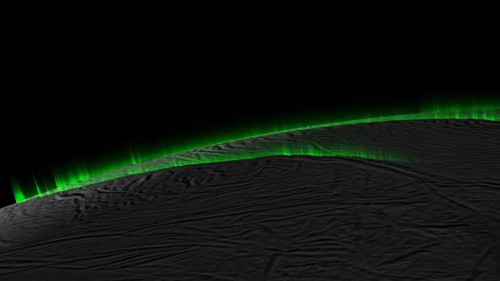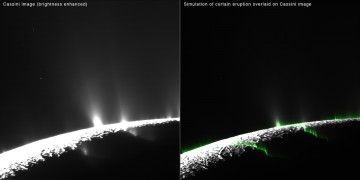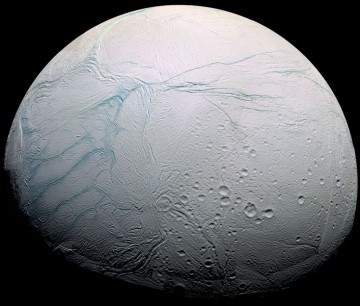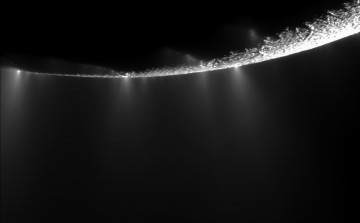
The water vapor geysers on Saturn’s moon Enceladus are one of the most fascinating phenomena in the Solar System; the jets spray far out into space in a dazzling display unseen anywhere else. Known to emanate from the “tiger stripe” fissures at the south pole, they were thought to be separate, distinct plumes erupting from the surface, but now scientists think that they might actually be mostly broader, more diffuse “curtains” of spray along the length of the fissures.
“We think most of the observed activity represents curtain eruptions from the ‘tiger stripe’ fractures, rather than intermittent geysers along them,” said Joseph Spitale, lead author of the study. “Some prominent jets likely are what they appear to be, but most of the activity seen in the images can be explained without discrete jets.” Spitale is also a participating scientist on the Cassini mission at the Planetary Science Institute in Tucson, Ariz.

The new results come from the study of data from the Cassini spacecraft, which is still orbiting Saturn. They will be published this Thursday in the journal Nature.
Spitale and his colleagues noticed there seemed to be a faint background glow in most of the images of the jets taken by Cassini. Computer modeling of the eruptions showed that they were more like uniform, diffuse curtains of spray rather than distinct jets. The brighter “plumes” were phantom images where a viewer was looking through a “fold” in the curtain. The folds are there because the fissures are more wavy than straight. Most of the individual jets would therefore be an optical illusion. But, as noted in the press release, “some discrete jets are still required to explain Cassini’s observations.” Previous observations had noted at least 101 locations along the Tiger Stripes where the water vapor was emanating from. That number may be less now, but there is still a lot of water vapor in total being shot out into space.
As Spitale noted: “The viewing direction plays an important role in where the phantom jets appear. If you rotated your perspective around Enceladus’ south pole, such jets would seem to appear and disappear.”
Seeing most of the jets as curtains rather than separate plumes would seem to simply depend on how the plumes are viewed. From one angle, they appear as separate, localized geysers, but from another angle, they look more like the broader, diffuse curtains of water vapor.

From the abstract of the new paper:
“Observations of the south pole of the Saturnian moon Enceladus revealed large rifts in the south-polar terrain, informally called ‘tiger stripes’, named Alexandria, Baghdad, Cairo and Damascus Sulci. These fractures have been shown to be the sources of the observed jets of water vapor and icy particles and to exhibit higher temperatures than the surrounding terrain. Subsequent observations have focused on obtaining close-up imaging of this region to better characterize these emissions. Recent work examined those newer data sets and used triangulation of discrete jets to produce maps of jetting activity at various times. Here we show that much of the eruptive activity can be explained by broad, curtain-like eruptions. Optical illusions in the curtain eruptions resulting from a combination of viewing direction and local fracture geometry produce image features that were probably misinterpreted previously as discrete jets. We present maps of the total emission along the fractures, rather than just the jet-like component, for five times during an approximately one-year period in 2009 and 2010. An accurate picture of the style, timing and spatial distribution of the south-polar eruptions is crucial to evaluating theories for the mechanism controlling the eruptions.”
These curtain eruptions would be similar to ones on Earth, where molten rock comes out of deep fissures, in places like Hawaii, Iceland, and the Galapagos Islands, creating “curtains of fire.” On Enceladus, however, the curtains are water vapor, originating deep underground where water is heated and escapes as steam through cracks in the surface—a surprising finding, since Enceladus is a tiny, otherwise icy moon. Gravitational tugging from Saturn, however, creates enough heat inside the moon to allow liquid water and the geysers.

“Our understanding of Enceladus continues to evolve, and we’ve come to expect surprises along the way,” said Linda Spilker, Cassini project scientist at NASA’s Jet Propulsion Laboratory, Pasadena, Calif. “This little ice world is becoming more exciting, not less, as we tease out new details about its subsurface ocean and astonishing geophysical activity.”
Even though the physical nature of the jets may be different than previously thought, it doesn’t take away from the fact they are evidence for a subsurface sea or ocean, something like on Jupiter’s moon Europa. Cassini has already flown directly through some of the plumes and sampled them, finding water vapor, ice crystals, salts, and organics. Scientists also now think that the water is similar in composition to soda lakes or seawater on Earth and in contact with a rocky mantle, again like Europa. The rocky mantle could provide nutrients for any possible life forms that may exist in this alien sea. There is also now evidence for hydrothermal activity on the sea bottom, much like volcanic vents on the bottom of oceans on Earth, which are known to provide a habitat for a wide variety of organisms deep below the surface. Could the same be true for Enceladus?
Regardless of their actual appearance, however, the geysers of Enceladus are an amazing discovery, showing what was once thought to be a frozen, inactive world to be one of the most geologically active places in the Solar System, and one in a growing list of worlds where liquid water is now known to exist outside of Earth. This makes Enceladus a prime target in the search for possible life elsewhere in the Solar System. Other moons thought to have liquid water oceans beneath the surface now include Ganymede, Titan, and, of course, Europa—possibly others and even some asteroids. This also indicates that such watery moons may be common elsewhere as well, in other solar systems. With the discovery now of thousands of exoplanets (and estimated to be in the billions), how many more worlds like Enceladus or Europa are out there?
More information about the Cassini mission is available here.
Want to keep up-to-date with all things space? Be sure to “Like” AmericaSpace on Facebook and follow us on Twitter: @AmericaSpace





“This makes Enceladus a prime target in the search for possible life elsewhere in the Solar System. Other moons thought to have liquid water oceans beneath the surface now include Ganymede, Titan and of course Europa, as well as possibly others and even some asteroids.”
Far more interesting than that rock called Mars. I find it so interesting that submarines may one day be the most needed tools for space exploration missions. Nobody would ever have guessed this during the first space age in the 60’s and early 70’s.
Even Ceres could have an ocean- we may found out very soon. Forget Mars.
Imagine a fleet of orbiters and landers sent to the Jupiter/Saturn systems to study, search and verify the habitability of one or moons. Such endeavors would provide the necessary comparative data that other scientists searching for exoplanets would need to verify such findings.
Looks remarkably like the auroral curtains of Earth seen from the International Space Station.
Gary and Tom, I think it’s pretty safe to say that you join me in wondering how anyone who has been trained to walk upright, wear clothing, and only relieve oneself indoors in specified locations could see the continuous stream of intriguing, tantalizing discoveries coming from Jupiter/Saturn and not DEMAND increased funding for missions of planetary exploration and manned human space flight. It is truly a pleasure to read your intelligent, insightful posts gentlemen.
Thanks Karol.
Reminds me of Laki from 1783
Intelligent spacecraft, designed by intelligent beings, making intelligent discoveries DEMANDS intelligent funding. Remember, the cost is, as I consistently state, “chump change” for the untold wealth of scientific return.
. . . and as I consistently state, “Tom Vasiloff for U.S. Congress!”